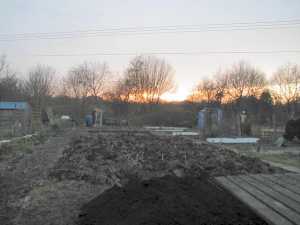The weather in February can swing from one extreme to the other but the light increases so it’s a good time to sow seeds and do more to your plot. Watch out for frost pockets, check your plot regularly and wait for the right conditions.
Provided the ground is not frozen or too wet to work complete your winter digging and incorporate as much organic matter as you can.
Start sowing cabbage, lettuce, peas and cauliflower in a heated greenhouse
Plant new rhubarb crowns just below the surface
You can start sowing parsnip seed, but it may be too cold to germinate
Plant broad beans in pots for an early crop
Check your stored potatoes from last year; rub off any sprouts appearing
Tie in new blackberry shoots as they appear and before they get too long
Start successional sowing of summer spinach
Start successional sowing of radishes
You can start sowing your onion sets now if the ground is not too hard or wet
Sow your first peas in pots in the cold frame or under fleece direct into the ground
Cover your strawberry patch with fleece or a cloche to warm up the ground
Prune blackcurrant bushes
Harvest cabbages, cauliflowers, brussels sprouts and kale along with leeks, celeriac, parsnips and swede for warming winter stews
Sow seeds indoors to raise seedlings for planting out in spring
Plant shallots and garlic
Chit seed potatoes, make sure you have purchased all the seed potatoes you need by the end of this month
Dig over your plot and add plenty of well rotted organic material
Force rhubarb, covering crowns should stimulate them into producing an early crop
Sow or plant in February
Broad beans – sow directly outside
Brussels sprouts, kohl rabi and sprouting broccoli – sow first early varieties under glass to plant out in April or May
Globe artichokes – sow in pots at a minimum temperature of 18C. Keep indoors until hardened off to plant out in April or May
Jerusalem Artichokes – plant tubers direct outside in a single row somewhere the plants won’t over shadow other crops when they reach their full height.
Lettuces – for crops ready to harvest in may and June sow indoors this month, thin out seedlings and plant in cold frames next month
Spinach – for an early crop in April or May sow a fast growing variety indoors and plant out in March
Tomatoes and Cucumbers – if your raising plants for a greenhouse sow seeds indoors now. to ensure germination use a heated propagator then maintain the temperature at a minimum of 21C
Summer Cabbages, Brussels Sprouts Broccoli, Leeks and Turnips
Fruit: Top dress all trees and soft fruit.
Plant new fruit trees or transplant old ones.
Hand pollinate early Peaches + Apricots with small paintbrush.
Prune autumn fruiting raspberries.
Force Rhubarb.
Move some strawberries in pots to the greenhouse for an earlier crop.
Prune: Make sure all diseased and dead wood is cut out of all fruit trees and bushes.
Finish fruit trees.
Move dead leaves from around vegetables as this may cause mould.
Spray fruit trees against pests with organic solution.
Net Gooseberries – birds will eat new shoots.
Check for hiding slugs and hibernating snails.
Dig runner Bean trench – fill with kitchen and green waste, cardboard, manure and compost.
Finish off winter digging.
Turn compost heaps or start new one.
Clean greenhouse – makes a big difference.
Check what soil you have (ph. test).
Plan your crop rotation.
Clean pots

